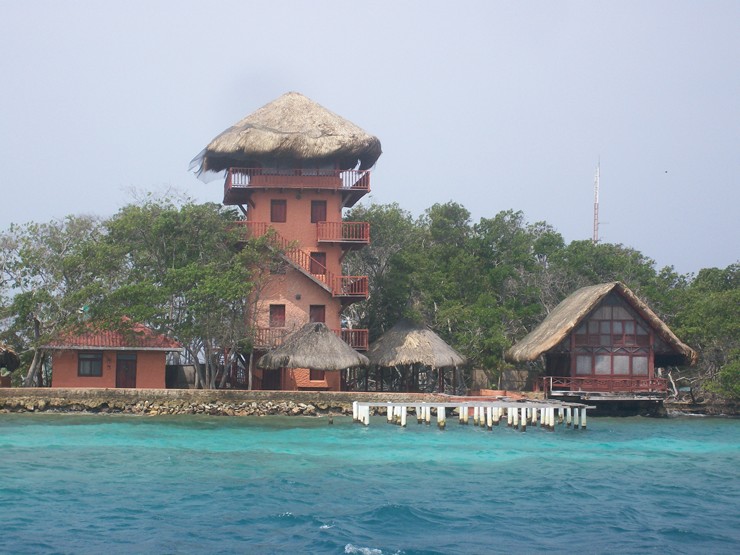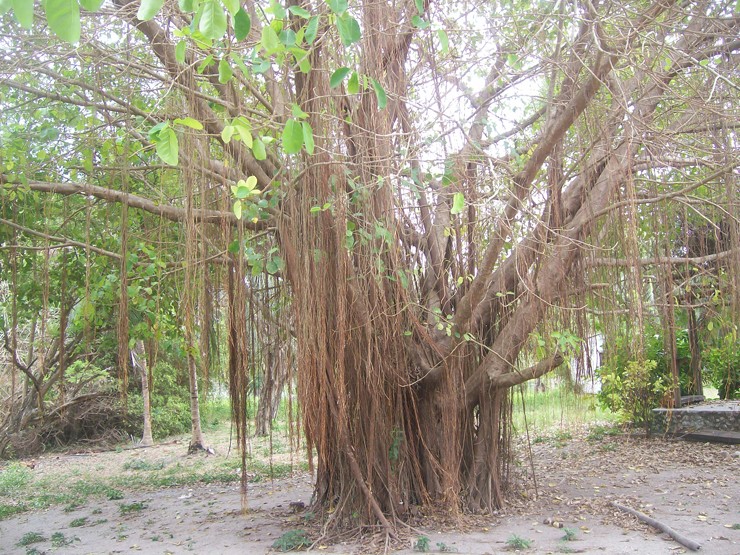Leaving Cartagena and on to Islas de Rosario N10 10 W75 45

|
The only anchorage at Cartagena is at the Club Nautico in a middle class residential part of the city where developments creep up into the sky. It has been hot, variously humid and with light breezes but it has started blowing harder now bringing heavy dust into the boat from the building site that is Club Nautico. The poor owners got their planning permission to rebuild, extend and update. They pulled down their old but characterful buildings and jetties and there now stand heaps of building materials below empty scaffolding surrounded by temporary rough and gritty pontoons. Planning permission has now been halted for review as the City Council are putting in a cycle path and they are pondering the relationship of this with Club Nautico's plans as the two coincide in parts. Meanwhile when the wind blows off the land the boats fill up with grit and dust – time to leave. We have booked ourselves into the only marina 'Shelter Bay' on this side of the Panama Canal for 13th March so now have 2 weeks to get there. We shall spend as much time as possible in the San Blas islands and hope to meet the Kuna Indians who live on some of the hundreds of islands just east of the canal off the Panama coast. En route we have permission from the Colombian authorities to stop over at the Islas de Rosario (Rosary Islands) some 18 miles off the coast, then it is goodbye to Colombia. Islas de Rosario The Rosarios, 3 hours sailing from Cartagena, are navigationally tricky and difficult to enter. A collection of coral islands, they are surrounded by and intertwined with dangerous reefs. The only reliable chart for the area is a hand drawn one provided at small expense by Club Nautico. Armed with this black and white print, highlighted with Biro markings, we used up much adrenalin as we crawled between guesswork posts marking the end of reefs and through some extremely narrow passages into sheltered anchorages but with dubious holding. We finally settled on one where the anchor would hold in sand and not be caught up by coral heads.
This is one of the most unusual places we have been, it is like a strange film set and very unexpected. Some of the islands are tiny but they each have an elaborate house and outbuildings perched on them, some with water lapping at the verandah and all with a small quay for a boat to tie up. They are mostly thatched, artistic and architecturally exciting though a few are in a state of sad disrepair and a few others quite dilapidated.
There are some fabulous new buildings like the Coast Guard Station. This is a huge building of bamboo and thatch held together with great ropes, two stories with wonderful first floor verandahs, no outer walls but thatch which almost reaches the ground. Inside is cool and shady, beautifully furnished with bamboo against polished stone floors. There is a hotel and a few restaurants of similar excellent thatched buildings.
Then there are the natives' homes which are poor, sad things. We abandoned a walk through the middle of the largest island (still quite small) due to the heaps of rubbish strewn everywhere. We walked past one abode where the man catapulted his dog with a stone to stop it barking at us. Difficult to know what to say or do in the circumstances so it felt best to keep away.
Most of the architectural wonders here belong to business men from Bogotá who use the islands as a weekend retreat. The crystal clear coralline waters are beautiful but it is a stark world of those who have much and those who have very, very little. It is difficult to see how it might continue, perhaps always the same.
Next morning the boat vendors arrived but very different to the colourful boat boys of the West Indies. These people are bone poor, they paddle skinny flat canoes from which they fish on the reefs. Many kinds of fish were brought but we don't eat reef fish, the lobsters they brought are out of season now and were so small they should never have been caught. We just gave one man some money, he brought his child who was unwell. Another we gave clothes, he was so pleased he couldn't stop grinning. When the weather is rough these men cannot fish but we saw pigs and chickens on the islands and fruit trees so they can still eat.
We don't know what this tree is, there were plenty about, this is one of two in the grounds of the Coast Guard Station. The islands appear to have long been populated. There are lots of what look like abandoned buildings although we discovered people living in some of them. Much of their time is spent outdoors, hammocks are much in evidence, but they need shelter in the rainy season. Despite a feeling of remoteness there were people everywhere. There is a fancy aquarium with performing dolphins on one of the islands and some fast ferry boats bringing visitors from the mainland arriving 2 or 3 times a day. The winds remained strong and so strong that we were unable to find a safe anchorage where we could land at the aquarium island. Consequently we decided to move on after only 2 nights and had a fast rough passage to the San Blas with the wind a good Force 6 on the beam and a steep high swell making life very uncomfortable. Under only a well reefed genoa and the mainsail safely stowed it took only 28 hours to do the 180 miles. |




